i had a go at this with my guitar (a tele) and i could easily get reliable triggering on the lower notes, but the e on the d string was jumping like crazy. so i guess it depends a lot on the guitar. i will have a go with a bass as well (i'm a bass player) i own a mxr octaver for bass and it tracks very well. but i assume bass is easier to track because it has less overtones. also i have a pcb and all the parts for the u-boat octaver and once that is built i can compare it to my axoloti implementation.
Lokki contributions
Hi there!
I did a patch working very closely to what you did with your custom objects, but with standard objects at k-rate, and yes, the guitar makes a huge difference on mine as well... humbucker - neck position - closed tone is the way to go, even better with flatwound strings. I guess string noise gets translated in false positives on the square wave, but this is something happening also on many analog octave dividers.
Can't test your objects right now, but I will ASAP, they look very promising. Thanks for sharing!
cool! let me know how it goes. also check out my octaver patch, it's easier then with guitar input to see there what it does to the original waveform...
I played a little with your octaver patch, great fun. The stitcher to me sounded a bit more synthetic than expected, but nicely... I also patched something mixing things with my previous krate version, check it outoctaver.axp (6.8 KB)
yeah, the stitcher only really works "perfectly" with synthesised source materials, in my example octaver patch it sounds very nice i think. for real world signals like guitar it distorts quite heavily. but this is the same on oc-2 and u-boat as well. you absolutely have to filter after the stitcher if you use guitar or something. but you get a waveform that reacts to your playing, which is nice. also you get dynamics for "free"...
your approach is interesting as well, will have a play with it tomorrow. why don't you use the unfiltered guitar signal as source for the xfade? i also had a couple of ideas to improve filtering/tracking, will test those as well 
It just sounded better for my purpose (oc-2 emulation)
Come on!!! We need that!
I thought I'll post here some patches I made (and that got a little better with your objects), always in the realm of octavers and guitar to synth, I hope you may have fun with them...
A better OC-2 emu octaver.axp (8.7 KB)
A multi-squarewave generator from guitar input plus filters square.axp (13.9 KB)
An extremely naive way to sound like a gr-300 with the Pat Metheny sound... saw.axp (12.4 KB)
Actually they're all naive, so any thought/advice is very welcome.
Frequency divider with setable divisor
patience, sorry. i will get there. my first naive approach did not yield any better tracking. maybe i will first have to build the real thing before adapting it. as i said i have the pcb and parts for the u-boat.
@valmir
you're patches sound pretty great, thx for sharing them here!
@lokki
this is a great start alreay looking forward to see this thing grow!
Hey @lokki! I just realized that changing the counter in your divider object to 3 or 4 will give me instant sub-fifth and sub-octave, so I have to thank you twice more... 
Man, if you ever would implement a multiplier (something like drj/seq/clk_mul but s-rate) you'd be my monophonic synth superhero...
yeah, @valmir i know that is an easy addition, i did only not include it, because it does not work well with the stitcher... but i could just make a dedicated divider object with sub (octave, fifth, whatever) control.
lokki/osc/auduloti
here is an auduino (arduino synth) port to axoloti. i simply implemented it as an oscillator, sounds great! very wide range of sounds, true to the original all restricted to arduino limits. (bit-depth etc.)
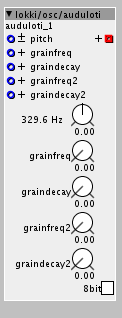
Auduino port feasible?
lokki/osc/extenduloti
same as above but with some control over the waveforms, broader spectrum of sounds. pulse width control is only available with waveform3 choosen.

lokki/env/radsr
stock adsr object that has two gate inputs. first one starts attack phase from last position, second one always starts from zero.
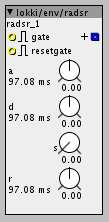
lokki/dist/destroyer
overflow those variables that store your precious samples!
nasty digital "distortion". with modulation input. at zero the signal is passed through unaffected.
works best with signals that have not much overtones, sine for example. kind of like a reversed filter...
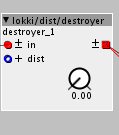
here is a short demo of the auduloti oscillator (2 of them). later on the destroyer module comes into play as well (you'll notice the volume change, hehe) all modulation is done via aftertouch. played on my midi ribbon bass. cheap drum sequence is a loop from the daw. no editing or efx on the axoloti output.
lokki/env/scahd
slow (cycling) ahd module.
ok, this is an ahd module that is REALLY slow at maximum settings and still quite slow at minimum settings  use it for noise sweeps or similar.
use it for noise sweeps or similar.
controls:
- a = attack time
- d = decay time
- divd = divisor of decay time, so that you can get faster decay times if needed
- cycle = enable/disable cyclemode.
- h = holdtime, in cyclemode this control sets the hold time at maximum before descending again. has no effect if cyclemode is disabled
note that you can freeze the output if you disable cyclemode while the signal decays.
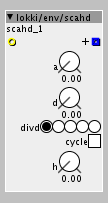
Really Slow ADSR
lokki/string/concat & lokki/string/concat8
two objects that can concatenate strings, either 4 or 8.
useful in combination with an OLED and @SmashedTransistors object for it. allows to generate menus etc.
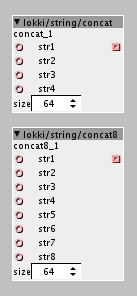
lokki/patch/name
output the name of the current running patch (has to be on sdcard) as a string. supports patchnames up to 13 characters. it is easy to make a version that supports longer names, but currently an OLED object can only hold 11 characters and i wanted to have a small memory footprint for this. let me know if you need bigger versions (if you want to scroll the name for example)
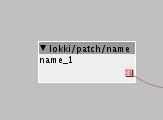
How to read out the patchname from sd/patch
lokki/modmatrix
a 10 source 22 destination matrix with mod amount for each mod matrix point that is chosen. multiple sources can go to one destination, they add up. supports bipolar and unipolar input and mod-direction can be changed with the bipolar mod-amount dials.
object is too big to fit my screen 
Help, connector matrix
Hi @lokki,
maybe it is possible to split it in two sorts of objects.
- the matrix input/output object.
- the link objects
The link objects will have an objref attribute pointing to the matrix object.
This way, it would fit on screen and it would be possible to add as many link object as wanted.

